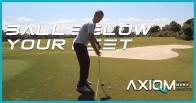Video Menu
My Favorite Videos
My Favorite Videos
Sidehill Lies - Ball Below Your Feet
Sorry, you need to be a member to access this video.
You Are Just Seconds Away - Become a member here!
Already a member? Log in now

Side hill lies can be challenging for golfers of any level. Learn a couple of quick setup checkpoints that will help you get the ball on the green every single time when the ball is below your feet.
- Add just a bit of knee flex for stability.
- Roll the ankles in slightly
- Aim a bit left
- Make sure you release the club.
Hey everyone, I'm Rotary Swing Instructor Chris Tyler.
Today, I'm going to teach you guys how to handle a ball below your foot situation on the golf course with ease.
Let's go ahead and get started.
Okay gang, So here we are today, faced with this really tricky ball below our foot situation on the golf course.
And the objective in today's video is just to give you a very clear understanding and a couple of checkpoints of what you're trying to accomplish here.
So that you can handle these golf shots with ease.
So a couple of the checkpoints that I like to use is number one, We got to get our lower body really stable to the ground.
And the reason being is because when we have, or we're making our golf swing here, we're going to have a lot of momentum and inertia.
Trying to pull you over your toes and throw you off balance and that can cause a lot of mishits and make your golf ball go all over the place.
So what we're going to do to counterbalance the slope here, Compensate for the slope and also get stability is we're just going to increase our knee flex just a fraction here.
Not a ton.
I don't want you sitting way down on your knees that can cause you to fire upwards and then we'll have another mess of problems on our hands.
But normally, what we're looking for is we want the back of the knee to be right over the center of the ankle.
So you're going to see.
I just increase it just a little bit to help compensate for the slope, and that's going to help you get stable to the ground here.
It's going to help you so you're not feeling like you're falling over your toes as you start your downswing.
Okay so we're just going to increase the knee flex just a little bit.
Next thing I'm going to do here is I'm going to roll my ankles in just slightly.
Now, rolling the ankles in slightly.
What that does is it gets you some contraction here in the upper part of your thighs, which is great for stability.
So again what we're looking for here is just a little bit of increase in knee flex.
Okay, roll the ankles in.
I'm going to increase my spine angle just a little bit, just to make sure my chest is over.
The ball here.
And our goal is to make sure that our weight stays right underneath our ankle joints throughout this entire golf swing.
Now, the next thing that you need to be aware of is because we have the ball below our feet.
What's going to happen is this ball is going to tend to move out to the right.
So we have to be able to play for that.
So I put this alignment stick down here so you could see the direction where I'm trying to hit this shot.
But what I'm going to do is I'm actually going to turn my feet just a little bit here.
And this is one of those things that you're going to have to play with at home to better understand how much your ball is going to curve.
But in order for us to really kind of overcome a lot of the curvature there, we're going to focus on our release today.
So, you're going to see here.
What I'm going to focus on is making sure that my forearms feel like they're almost touching each other as I release the club.
Okay, so you're going to see that as I finish.
Now, this toe of the club is releasing a little bit harder.
That's going to help me compensate for the slope as well.
So again your checkpoints are increase the knee flex just a little bit, roll the ankles in, ball position is going to remain the same, we're going to turn our body just a little bit and then we're going to focus on making sure that when we release the club that our forearms feel like they're relaxed and rolling over the top of each




































































































































































































































































































































































































































































































John
Craig (Certified RST Instructor)
William
Craig (Certified RST Instructor)
William
Tyson
Tyson
gordon
Craig (Certified RST Instructor)
gordon
Craig (Certified RST Instructor)
Steven
Craig (Certified RST Instructor)
Steven
Craig (Certified RST Instructor)
Steven
Michael
Craig (Certified RST Instructor)
Andrew
Craig (Certified RST Instructor)
Andrew
Craig (Certified RST Instructor)
Andrew
Mark
Craig (Certified RST Instructor)